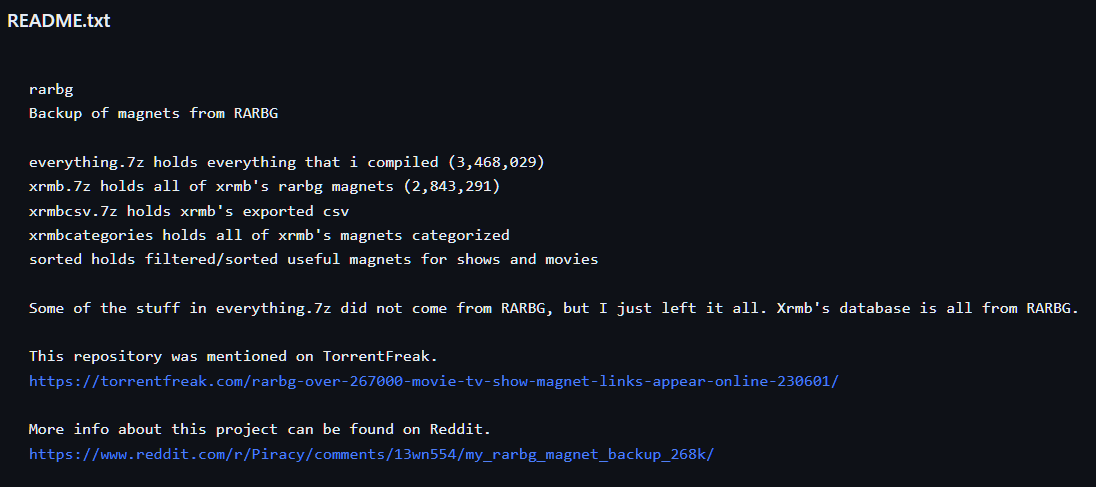The shutdown of major torrent site RARBG in May sent shockwaves through the entire pirate ecosystem. As part of an effort to preserve access to content, archivists began uploading RARBG magnet link databases to platforms including GitHub. One repo was forked 900 times but a single DMCA notice sent by a single rightsholder has wiped every last one from GitHub. Their identity is a secret.
The most dependable things in life tend to be the things most easily taken for granted. In the piracy ecosystem, that certainly applied to torrent site RARBG.
RARBG was never likely to win any prizes for being the best-looking site with bleeding-edge features. Nor would its operators hope to win any. What the site did was what any indexer of any content should strive for; plenty of well-organized and readily searchable content, all of it supported by ancillary sources of complementary data, with very little downtime and zero drama.
Until the site threw in the towel in May, RARBG met all of these requirements and made it look easy. The decision to shut down obviously came as a shock, but the complete lack of notice took everyone by surprise. There would be no closing down event, and no last few days to grab whatever people had taken for granted would always be available.
Backups Are Boring
As computing tasks go, backups are indeed pretty boring. The same can’t be said about not having a backup when you absolutely need one. A split-second decision to backup The Pirate Bay in 2006 saved the site and thanks to the silent work of archivists over several years, RARBG’s massive magnet link database didn’t die along with the site.
Following the RARBG shutdown, magnet link databases appeared on forums, file-hosting sites, even packaged up as torrents themselves. One early upload of more than 270,000 links appeared on GitHub and then took on a life of its own as contributors added to the database and created their own forks.
A subsequent readme file suggests that the archive later contained over six million magnet links, possibly one of the largest collections ever seen.

But just as RARBG gave no notice of its demise, these backups of backups also abruptly disappeared this week, removed by GitHub in response to a copyright complaint.
Entire Repositories Declared Infringing
Given the sheer volume of magnet links in the original repository, the chances of being hit with a DMCA takedown notice from one or more rightsholders from a pool of thousands were always relatively high. A mainstream rightsholder in the movie or music industry would’ve been a relatively safe prediction but would’ve been wide of the mark in this case.
“This letter is a Notice of Infringement as authorized in 512(c) of the U.S. Copyright Law,” the DMCA notice reads.
“I am the copyright owner of the works and the following is true and accurate. I own full rights to these videos. I also have 2257’s, ID’s and model releases for them. I also have signed documents from the original producer(s) certifying I own them.”
Unusually, the DMCA notice published by GitHub lists no original works whatsoever. Presumably, they were present in the original notice and for some reason GitHub made a decision to redact. What we can deduce from the above is that the mention of ‘2257’ is a reference to 18 U.S.C §§ 2257 and the legal requirement to keep name and age verification records relating to performers in adult movies.

The DMCA notice initially lists four repositories (1,2,3,4) along with a request to remove them in their entirety.
“These entire repositories are infringing as they shares multiple links to content for which I own copyrights to. They also shares and provide ways to facilitate piracy of said content [sic],” the notice adds.
GitHub removed them but the end result was much more comprehensive.
It’s Over 900!
In addition to the first four named repos, the complaint demanded the removal of forks. Lots and lots of forks.
A note from GitHub states that because the reported network containing the allegedly infringing content was larger than 100 repos, and the submitter alleged that the forks were “infringing to the same extent” as the parent repository, the notice was actioned against the entire network.
What began as a takedown of a network of 45 repositories, ended up as a comprehensive takedown of 900 repositories, parent repository included.
Identity of DMCA Notice Sender: Unknown
In the interests of privacy, GitHub quite rightly redacts personal information from DMCA notices, but only rarely does it completely redact all information that would enable the identification of the sender. In this case, all information has indeed been redacted.
We can only speculate why GitHub made this decision, but one option is that the sender represented in a personal capacity (rather than under a corporate entity). It’s possible that they have a personal interest in the content beyond simply owning it, but those are the kind of details the redaction is designed to cloak.
The final question relates to the magnet links and the allegedly infringing content claimed to be connected to them. RARBG has been offline for more than a month, plenty long enough for there to be zero seeds or peers left in any number of swarms.
So, on one hand the magnet links referenced in the notice could be considered as facilitating infringement, if they still work. On the other, if the swarm has already died, those magnets are just strings of text and of use to no one. If anyone has a backup of the backup of the backup, over six million magnets need to be checked, just to be sure.
The DMCA takedown notice can be found here



3175x175(CURRENT).thumb.jpg.b05acc060982b36f5891ba728e6d953c.jpg)
Recommended Comments
There are no comments to display.
Join the conversation
You can post now and register later. If you have an account, sign in now to post with your account.
Note: Your post will require moderator approval before it will be visible.